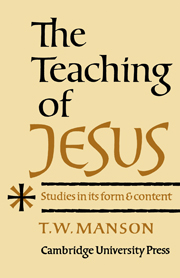Book contents
- Frontmatter
- Contents
- Preface
- LIST OF ABBREVIATIONS
- PART I PRELIMINARY QUESTIONS
- Chap. I Introduction: Problems and Methods
- Chap. II The Sources
- Chap. III Formal Characteristics of the Teaching
- Detached Note A. On Mt. xii. 28; Lk. xi. 20 (Q)
- Detached Note B. The Parable of the Wedding Feast (Mt. xxii. 1–14)
- PART II THE CONTENTS OF THE TEACHING
- Appendices I–VI
- Additional Notes
- General Index
- Reference Index
Detached Note A. On Mt. xii. 28; Lk. xi. 20 (Q)
Published online by Cambridge University Press: 31 March 2010
- Frontmatter
- Contents
- Preface
- LIST OF ABBREVIATIONS
- PART I PRELIMINARY QUESTIONS
- Chap. I Introduction: Problems and Methods
- Chap. II The Sources
- Chap. III Formal Characteristics of the Teaching
- Detached Note A. On Mt. xii. 28; Lk. xi. 20 (Q)
- Detached Note B. The Parable of the Wedding Feast (Mt. xxii. 1–14)
- PART II THE CONTENTS OF THE TEACHING
- Appendices I–VI
- Additional Notes
- General Index
- Reference Index
Summary
Mt. xii. 28: εἰ δὲ ἐν πνεύματι θεοῦ ἐγὼ ἐκβάλλω τὰ δαιμόνια, ἄρα ἔϕθασεν ἐϕ̉ ὑμᾶς ἡ βασιλεία τοῦ θεοῦ.
Lk. xi. 20. The same with the substitution of δακτύλῳ for πνεύματι.
This case first excites interest on account of this one striking difference in the midst of a word-for-word agreement between the two Evangelists. The problem is to account for the difference and to determine which of the two variants is to be regarded as the original. What stood in the document which St Matthew and St Luke are obviously copying here? Instinctively one looks first for a possible Aramaic original which might be mistranslated; but no such word presents itself: and we have to explore the second possibility, that one or other of the Evangelists has revised the Greek text which lay before him. The result of this enquiry is to make it practically certain that the original reading is δακτύλῳ and that πνεύματι in Matthew is an editorial modification. For this conclusion the following reasons may be advanced:
(a) πνεῦμα is a favourite word with St Luke. If it stood in the text of Q which lay before him, it is difficult to see why he should have altered it.
(b) A reason—the desire to remove an anthropomorphism—can be suggested for the change of δακτύλῳ to πνεύματι; but no really convincing reason can be given for the opposite change.
- Type
- Chapter
- Information
- Teaching of Jesus , pp. 82 - 83Publisher: Cambridge University PressPrint publication year: 1935

